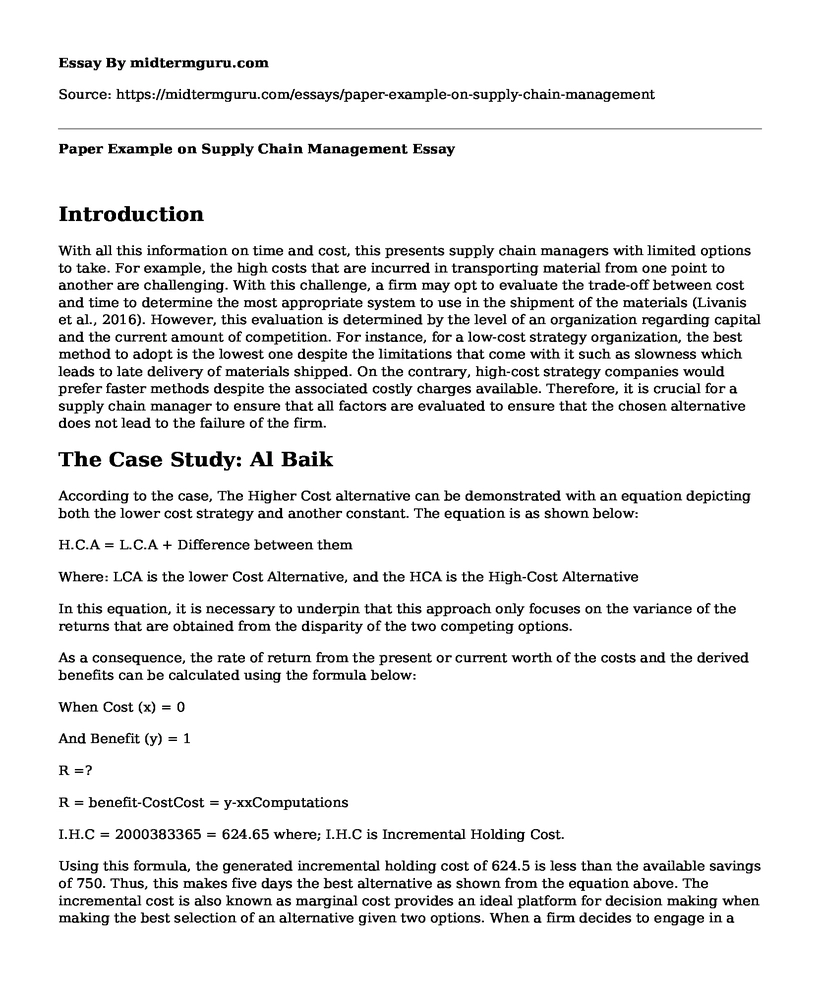Introduction
With all this information on time and cost, this presents supply chain managers with limited options to take. For example, the high costs that are incurred in transporting material from one point to another are challenging. With this challenge, a firm may opt to evaluate the trade-off between cost and time to determine the most appropriate system to use in the shipment of the materials (Livanis et al., 2016). However, this evaluation is determined by the level of an organization regarding capital and the current amount of competition. For instance, for a low-cost strategy organization, the best method to adopt is the lowest one despite the limitations that come with it such as slowness which leads to late delivery of materials shipped. On the contrary, high-cost strategy companies would prefer faster methods despite the associated costly charges available. Therefore, it is crucial for a supply chain manager to ensure that all factors are evaluated to ensure that the chosen alternative does not lead to the failure of the firm.
The Case Study: Al Baik
According to the case, The Higher Cost alternative can be demonstrated with an equation depicting both the lower cost strategy and another constant. The equation is as shown below:
H.C.A = L.C.A + Difference between them
Where: LCA is the lower Cost Alternative, and the HCA is the High-Cost Alternative
In this equation, it is necessary to underpin that this approach only focuses on the variance of the returns that are obtained from the disparity of the two competing options.
As a consequence, the rate of return from the present or current worth of the costs and the derived benefits can be calculated using the formula below:
When Cost (x) = 0
And Benefit (y) = 1
R =?
R = benefit-CostCost = y-xxComputations
I.H.C = 2000383365 = 624.65 where; I.H.C is Incremental Holding Cost.
Using this formula, the generated incremental holding cost of 624.5 is less than the available savings of 750. Thus, this makes five days the best alternative as shown from the equation above. The incremental cost is also known as marginal cost provides an ideal platform for decision making when making the best selection of an alternative given two options. When a firm decides to engage in a contract, it is critical or essential for it to evaluate the trade-off between revenues and costs (Davis-Sramek et al., 2017). In this case, the revenues must be higher to offset the effects of the incremental costs. The motive to do this is to ensure that circumstances that may lead to losses are not experienced at all which would be detrimental to the operation of a business.
Conclusion
It is evident that supply chain managers face severe challenges in their pursuit to adopt the best alternatives in their work. In their attempts to find the best choices, it is crucial for them to consider the aspects of time. Also, they have to contend on finding the best alternative to choose from the available options. In this case, they have a choice of getting an alternative that takes one or two-day delivery or adopts the less expensive one though it is a slower one. The prime factors, however, justify the need to select a faster as well as a quicker alternative and the authorizing organization having no impact in this issue (Albuloushi & Algharaballi, 2014). In this case, the earlier decision will entail picking the incremental holding costs that emanate from using slower alternatives and quick alternatives that accentuate savings on costs (Livanis et al., 2016). Thus, it is prudent for the firm to approve the five-day alternative since the marginal cost is less than its savings.
References
Albuloushi, N., & Algharaballi, E. (2014). Examining the influence of the cultural aspects of uncertainty avoidance on supply chain coordination. The Journal of Applied Business Research, 30(3), 847-862.
Davis-Sramek, B., Fugate, B. S., Miller, J., Germain, R., & Izyumov, A. (2017). Understanding the present by examining the past: Imprinting effects on supply chain outsourcing in a transition economy. Journal of Supply Chain Management, 53(1), 65-86.
Livanis, G., Robertson, C. J., Al-Shuaibi, K. M., & Hussain, K. (2016). Outsourcing destination choices: The role of economic and cultural attributes. International Marketing Review, 33(1), 51-87.
Morieux, Y. (2013, October). Yves Morieux: As work gets more complex, 6 rules to simplify [Video file]. Retrieved from http://www.ted.com/talks/yves_morieux_as_work_gets_more_complex_6_rules_to_simplify
Stevenson, W. (2015). APL [Video file]. Retrieved from http://www.viddler.com/embed/49f451d8/?f=1&autoplay=0&player=full&disablebranding=0
Stevenson, W. (2017). Operations management (13th ed.). New York, NY: McGraw-Hill Irwin. ISBN-13: 9781259667473
Cite this page
Paper Example on Supply Chain Management. (2022, Sep 25). Retrieved from https://midtermguru.com/essays/paper-example-on-supply-chain-management
If you are the original author of this essay and no longer wish to have it published on the midtermguru.com website, please click below to request its removal:
- Life and Debt Documentary Film
- Essay on Impact of Western Consumer Ethics on the Fashion Industry
- Baby Pram Breaks, Kylie's Nanny in the Line of Fire - Case Study
- Indigenous People: Contrasting Global Capitalism & Traditional Perspectives - Research Paper
- Brie Files Discrimination Charge Against Employer: Legal Process Explained - Essay Sample
- Equal Employment: Overcoming Racism, Homelessness to Achieve Success - Essay Sample
- Company's Ignorance of CSR Leads to Emission Crisis - Essay Sample







